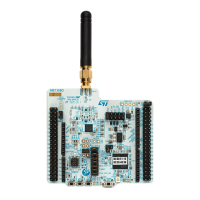Analog-to-digital converter (ADC) RM0453
554/1450 RM0453 Rev 5
18.5.3 Managing a sequence of data converted without using the DMA
If the conversions are slow enough, the conversion sequence can be handled by software.
In this case the software must use the EOC flag and its associated interrupt to handle each
data result. Each time a conversion is complete, the EOC bit is set in the ADC_ISR register
and the ADC_DR register can be read. The OVRMOD bit in the ADC_CFGR1 register
should be configured to 0 to manage overrun events as an error.
18.5.4 Managing converted data without using the DMA without overrun
It may be useful to let the ADC convert one or more channels without reading the data after
each conversion. In this case, the OVRMOD bit must be configured at 1 and the OVR flag
should be ignored by the software. When OVRMOD = 1, an overrun event does not prevent
the ADC from continuing to convert and the ADC_DR register always contains the latest
conversion data.
18.5.5 Managing converted data using the DMA
Since all converted channel values are stored in a single data register, it is efficient to use
DMA when converting more than one channel. This avoids losing the conversion data
results stored in the ADC_DR register.
When DMA mode is enabled (DMAEN bit set in the ADC_CFGR1 register), a DMA request
is generated after the conversion of each channel. This allows the transfer of the converted
data from the ADC_DR register to the destination location selected by the software.
Note: The DMAEN bit in the ADC_CFGR1 register must be set after the ADC calibration phase.
Despite this, if an overrun occurs (OVR = 1) because the DMA could not serve the DMA
transfer request in time, the ADC stops generating DMA requests and the data
corresponding to the new conversion is not transferred by the DMA. Which means that all
the data transferred to the RAM can be considered as valid.
Depending on the configuration of OVRMOD bit, the data is either preserved or overwritten
(refer to Section 18.5.2: ADC overrun (OVR, OVRMOD) on page 552).
The DMA transfer requests are blocked until the software clears the OVR bit.
Two different DMA modes are proposed depending on the application use and are
configured with bit DMACFG in the ADC_CFGR1 register:
• DMA one shot mode (DMACFG = 0).
This mode should be selected when the DMA is programmed to transfer a fixed
number of data words.
• DMA circular mode (DMACFG = 1)
This mode should be selected when programming the DMA in circular mode or double
buffer mode.
DMA one shot mode (DMACFG = 0)
In this mode, the ADC generates a DMA transfer request each time a new conversion data
word is available and stops generating DMA requests once the DMA has reached the last
DMA transfer (when a transfer complete interrupt occurs, see Section 1: Direct memory
access controller (DMA) on page 232) even if a conversion has been started again.

